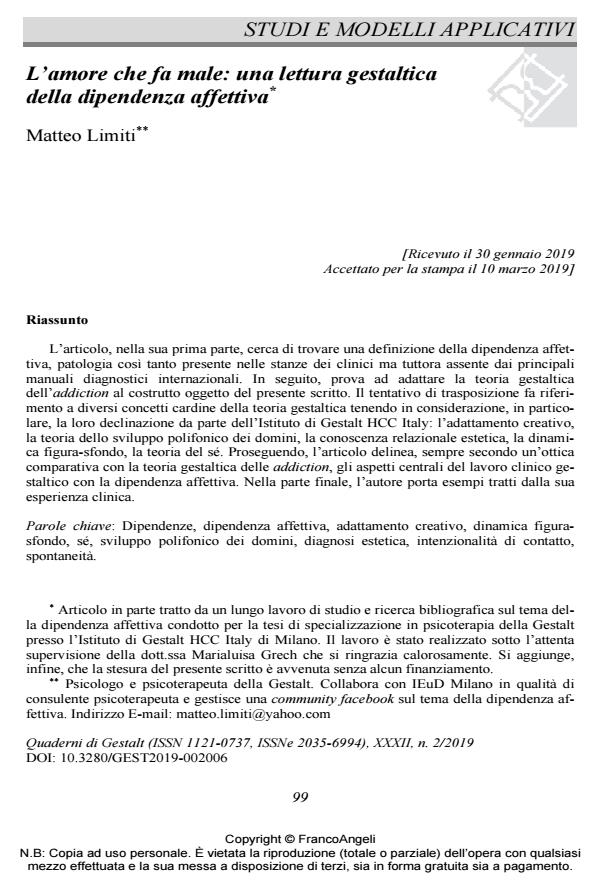Love That Hurts: A Gestalt Therapy Approach to Love Addiction
Journal title QUADERNI DI GESTALT
Author/s Matteo Limiti
Publishing Year 2020 Issue 2019/2
Language Italian Pages 16 P. 99-114 File size 231 KB
DOI 10.3280/GEST2019-002006
DOI is like a bar code for intellectual property: to have more infomation
click here
Below, you can see the article first page
If you want to buy this article in PDF format, you can do it, following the instructions to buy download credits

FrancoAngeli is member of Publishers International Linking Association, Inc (PILA), a not-for-profit association which run the CrossRef service enabling links to and from online scholarly content.
Starting from the best-seller of the American psychotherapist Robin Norwood, the article - in its first part - tries to find a definition of the concept of love addiction, a well spread suf-fering, known to psychotherapists but still absent from the main international diagnostic manuals. Borrowing the conceptualization of Reynaud et al. (2010), the present paper identifies the phenomenological-clinical and neurobiological similarities between love addiction and drug addiction, and distinguishes between a narrow view and a broad view regarding the treatment of these forms of suffering. In the second part, given the current lack of Gestalt therapy litera-ture, the author tries to apply a Gestalt model for addictions (Pintus e Crolle Santi, 2014) to the construct of love addiction. This attempt refers to several key concepts of Gestalt therapy and takes into account their specific declination by the Institute of Gestalt HCC Italy: creative ad-justment, polyphonic development of the domains, aesthetic diagnosis, figure-ground organi-sation, theory of the self. It is agreed that, as with any other addiction, the intentionality of con-tact moves towards the attainment of an experience of recognition. This is even more true for love addicts, for whom we can hypothesize that their need for a totalizing and saving bond is an attempt to compensate for unsatisfactory childhood experiences characterized by the pres-ence of a caregiver not in tune with their emotional needs. Afterwards, the paper outlines, according to a comparative perspective with the gestalt therapy theory of addiction, the crucial aspects of clinical Gestalt work with love addiction: a non-abstinent approach, the acceptance of the intentionality of contact, the restoring of the fig-ure-ground’s organisation, the resensitisation of the contact boundary and the reowning of spontaneity in contacting the environment, the construction of new and more functional crea-tive adaptations. What has been stressed here is the importance of an aesthetic approach that captures the vitality of the co-created figure between patient and therapist. Finally, the author brings some examples drawn from his clinical experience: Gestalt-oriented psychotherapy with men and women affected by love addiction and his experience as moderator of a virtual community of self-help for people who suffer of this pathology.
Keywords: Addictions, love addiction, creative adjustment, figure-ground organisation, self, polyphonic development of domains, aesthetic diagnosis, intentionality of contact, spontaneity.
Matteo Limiti, L’amore che fa male: una lettura gestaltica della dipendenza affettiva in "QUADERNI DI GESTALT" 2/2019, pp 99-114, DOI: 10.3280/GEST2019-002006